Border crossings between Turkey and the earthquake zones in northwest Syria
Preface
The border crossings between Turkey and the areas hit by the earthquake in northwestern Syria on February 6, 2023 extend at a distance of approximately 200 km, and the Turkish borders are the only land areas through which countries and organizations can respond to calls for humanitarian intervention, after the Syrian opposition areas were declared as afflicted areas and in need of various types of urgent intervention.
First: The border crossings between Turkey and opposition areas in northwestern Syria
The opposition areas in northwestern Syria are connected to the Turkish territory through a number of main land border crossings, which are:
1. Bab al-Hawa crossing: the largest and most important border crossing, connecting the Idlib governorate in northwestern Syria and the Hatay province in southern Turkey. It is a civilian and commercial crossing, and it is the only crossing approved by the United Nations for the passage of humanitarian aid convoys in accordance with Security Council Resolution 2672 (January 9). 2023).
2. Bab al-Salamah crossing: the second crossing in importance. It connects the governorate of Aleppo in northern Syria and the Kilis province in southern Turkey. It is a civilian and commercial crossing, and it was among the crossings approved for the entry of UN aid by Resolution 2165 (2014) until the renewal of aid entry through it was stopped by Resolution 2533. (2020).
3. Al-Ra i’ Crossing: It connects the two cities of Al-Ra i’ in Aleppo, northern Syria, and Goban Bay, southern Turkey. It is a civil and commercial crossing.
4. Jarabulus Crossing: It connects the cities of Jarabulus in northern Syria, and Karkamish in southern Turkey. It is a civil and commercial crossing.
5. Hammam crossing: Itis a new crossing established in 2019 . It connect s the city of Jenderes in the Afrin district in northwestern Syria, and the Hatay province in southern Turkey. At the beginning of its establishment, it was a military crossing, then it was expanded to become a civilian and commercial crossing as well.
Some of these crossings are international, and they are among the major crossings at the level of border crossings in Syria. Each of these crossings accommodates more than 500 commercial trucks per day, while the maximum capacity of some of them, such as the Bab al-Hawa crossing, reaches 1,000 trucks per day.
Second: The status of crossings and roads in northwest Syria after the earthquake
All crossings linking northwestern Syria with Turkish territory remained suitable for the passage of humanitarian aid convoys, whether the roads leading to them from within Turkish territory, or the roads branching from them to the earthquake-affected areas inside Syrian territory. The exceptions were the roads leading to Bab al-Hawa and Hammam crossings from the Turkish side, which were affected by the earthquake before emergency teams could repair the damage and open the roads properly and safely within 48 hours of the earthquake.
However, with the safety of most of the roads and the urgent repair of those affected, there remained a state of confusion in movement and access due to the expansion of the destruction caused by the first earthquake and the series of earthquakes that followed it, and because of the weather condition that Turkey and northern Syria were going through as a result of the snow storm.
Third: Humanitarian intervention through the land crossings after the earthquake
During the first 72 hours of the earthquake disaster, no UN or international aid entered the affected areas in northwestern Syria, despite the calls of the organizations and authorities responsible for these areas for the necessity of regional and international intervention. Local organisations – on top the Syrian civil defence organisation and local volunteer teams - made great efforts with limited capabilities to follow up on search and rescue operations, recover the bodies of the victims, treat the injured, and secure food, water, warmth, and shelter for the survivors.
The first UN aid convoy entered the Bab Al-Hawa crossing in the middle of February 9, 2023. This external intervention is considered the first after the disaster. The convoy that entered; however, was part of the regular aid program that was suspended due to the disaster. Moreover, it is expected that, with this convoy, the United Nations must have begun a road test to deliver aid; so that it would run the disaster intervention convoys afterwards.
Conclusion
The earthquake-afflicted areas in northwestern Syria suffered from an acute shortage of all kinds of humanitarian needs, emergency teams, and rescue mechanisms and equipment. With the great attrition occurring in the vast areas hit by the earthquake in southern Turkey; no foreign aid or intervention reached the afflicted areas in the first three days of the disaster.
It is unlikely that the reason for the delay in the arrival of aid was logistical, as most of the roads and land crossings were passable. Moreover, there is international capability to intervene by dropping aid from the air. However, it was clear that there was international and UN slowdown and procrastination in opening lines of humanitarian intervention despite the need to activate the highest levels of emergency humanitarian response.
With missing people under the rubble, and with survivors suffering from the difficulties of lack of food, water, medicine, shelter, and low temperatures; this UN and international slowdown has exacerbated human suffering, diminished the chances for saving many lives, and exhausted the depleted local groups and teams in the disaster areas.








